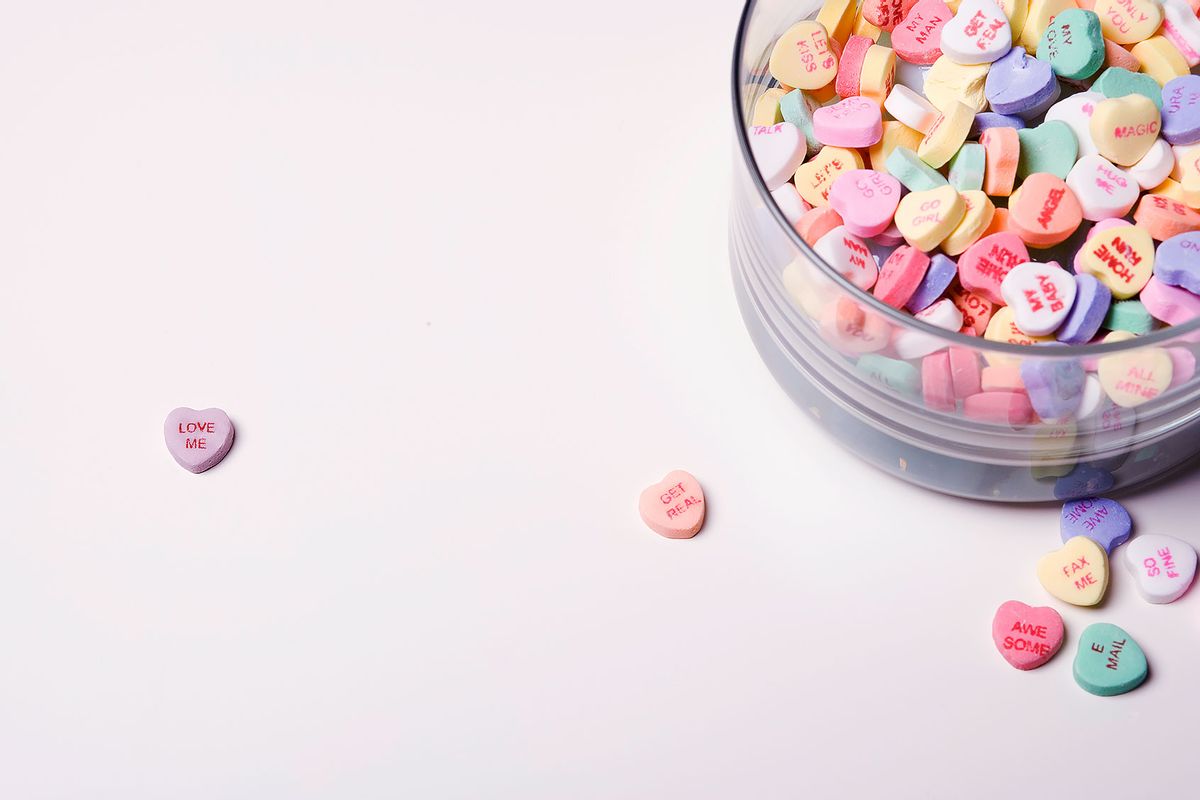Alongside heart-shaped boxes of chocolate, Sweethearts are enjoying their moment under the spotlight during Valentine’s Day week. The confectionery hearts are both sweet in taste and nature, flaunting an array of brief yet heartfelt messages on each candy. In the wake of the internet and online dating apps, those messages have taken on new meaning, mainly to poke fun at shifting attitudes about dating.
Sweethearts — also known as conversation hearts — were created in 1847, when a Boston pharmacist named Oliver Chase invented a machine that made it easier to create apothecary lozenges. The machine itself rolled lozenge dough and pressed them into perfect discs, thus eliminating the use of mortar and pestle to manually knead, roll and cut out the dough. Unbeknownst to Oliver, he had created America’s first candy-making machine. Originally set on making medicinal lozenges to help alleviate sore throat and bad breath, Oliver began creating candy — and founded a profitable business along the way.
Amid the 1800s, Chase and his brother Daniel Chase debuted their Sweethearts Conversation Hearts, which were released under Oliver’s company, the New England Confectionery Company (NECCO). Originally called “motto hearts,” the heart-shaped candies were conceived from a “cockle,” a Civil War-era scalloped candy that contained a wholesome message written on colored paper inside it, akin to a fortune cookie. It was Daniel who eventually came up with the idea of emblazoning words directly on the candy with red vegetable dye, explained Louise McCready for Bon Appétit. Such candies were first available in shapes like baseballs, horseshoes, and watches. The wedding-themed versions featured lengthy yet witty sayings, including “Married in pink, he will take a drink,” “Married in White, you have chosen right,” and “Married in Satin, Love will not be lasting.”
Conversation hearts took off by the early 1900s. They had become smaller in size and featured one-liners, which remain an enduring characteristic. Many of the original sayings, like “Be Mine,” “Kiss Me,” “Be Good” and “Be True,” are still printed on candies today. But in the late 90's, NECCO began changing up its phrases in accordance with a yearly theme. In 1997, NECCO featured expressions like “Email Me,” “Call Me” and “Fax Me” to spotlight technology’s growing impact on people’s romantic relationships. The early ‘80s were deemed peak years for faxing since fax machines were used for all types of office communication. Computer-based messaging became a reality in 1971, shortly after the fax machine’s inception, when the first ARPANET network mail was sent. In the late ‘90s, cell phones became a primary communication tool that slowly replaced landlines and online messaging.
We need your help to stay independent
In 1998, the candies “took a youthful approach,” per The State Journal-Register, with sayings like “Cool Dude” and “Yeah Right.” Pop culture was the theme in 1999, with the addition of “1-800-Cupid” and “As If.” In an attempt to modernize the candy’s phrases, NECCO asked consumers for suggestions in an online poll in 2010. The top choice was “Tweet Me,” which came amid Twitter’s growing popularity, while the second most popular choice was “Text Me.” The new phrases replaced “Email Me” and “Fax Me,” which had grown outdated.
Last year, Sweethearts poked fun at the concept of sending “likes'' on social media with its “The IRL Like” box of candy hearts. Unlike an online like, Sweethearts’ like is edible, comes in pretty colors and “shows someone you’re really thinking of them,” the company said on social media. “It’s giving real human connection. And also a sugar rush,” Sweethearts wrote.
Want more great food writing and recipes? Subscribe to Salon Food's newsletter, The Bite.
Most recently, Sweethearts launched its now sold-out box of "Situationship" candy hearts, which feature “messages as blurry as your relationship.” A situationship, by definition, is “a romantic or sexual relationship that is not considered to be formal or established.” The buzzy term is yet another subset of casual relationships that has arisen to popularity (albeit, unfortunately) within the internet dating culture. Online dating — which has become the norm recently as more folks look to Tinder, Bumble or Hinge to find a partner — has “created this paradox of choice,” Christie Tcharkhoutian Kederian, PhD, LMFT, a renowned relationship expert and former celebrity matchmaker at eHarmony told Women’s Health. That means more people are unwilling to commit to relationships because they have an abundance of options readily available.
As online dating continues to reign supreme in 2024, dating experts predicted several major trends that are slated to take over this year. There’s “contra-dating,” which relationship coach Jonathan Hartley from PositivesDating explained is a term “used when you want to broaden your horizon” and pursue “someone you would not usually go for.” There’s also “micro-flirting,” a fairly new (but growing) dating trend that describes “flirting in a subtle, not-so-obvious way.” And there’s the infamous ghosting, which is when someone suddenly ends all communication with the person they’re dating sans any explanation.
Keeping up with dating trends on top of navigating the current dating scene is quite frankly exhausting. But at least we have Sweethearts to continually keep us up to date — even humble us and remind us how abysmal our love lives truly are.



Shares